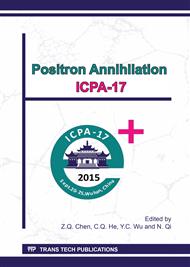[1]
S.G. Karshenboim, Precision physics of simple atoms: QED tests, nuclear structure and fundamental constants, Phys. Rep. 422 (2005) 1-63.
DOI: 10.1016/j.physrep.2005.08.008
Google Scholar
[2]
M. Deutsch, S.C. Brown, Zeeman Effect and Hyperfine Splitting, Phys. Rev. 85 (1952) 1047- 1048.
DOI: 10.1103/physrev.85.1047
Google Scholar
[3]
A.P. Mills, Jr., G.H. Bearman, New Measurement of the Positronium Hyperfine Interval, Phys. Rev. Lett. 34 (1975) 246-250.
DOI: 10.1103/physrevlett.34.246
Google Scholar
[4]
A.P. Mills, Jr., Line-shape effects in the measurement of the positronium hyperfine interval, Phys. Rev. A 27 (1983) 262-267.
DOI: 10.1103/physreva.27.262
Google Scholar
[5]
M.W. Ritter, P.O. Egan, V.W. Hughes, K.A. Woodle, Precision determination of the hyperfinestructure interval in the ground state of positronium. V, Phys. Rev. A 30 (1984) 1331-1338.
DOI: 10.1103/physreva.30.1331
Google Scholar
[6]
A. Ishida, T. Namba, S. Asai, T. Kobayashi, H. Saito, M. Yoshida, K. Tanaka, A. Yamamoto, New precision measurement of hyperfine splitting of positronium, Phys. Lett. B 734 (2014) 338-344.
DOI: 10.1016/j.physletb.2014.05.083
Google Scholar
[7]
A. Ishida, New Precise Measurement of the Hyperfine Splitting of Positronium, J. Phys. Chem. Ref. Data 44 (2015) 031212.
Google Scholar
[8]
M. Baker, P. Marquard, A.A. Penin, J. Piclum, M. Steinhauser, Hyperfine Splitting in Positronium to O(α7me): One Photon Annihilation Contribution, Phys. Rev. Lett. 112 (2014) 120407.
DOI: 10.1103/physrevlett.112.120407
Google Scholar
[9]
G.S. Adkins, R.N. Fell, Positronium hyperfine splitting at order mα7: Light-by-light scattering in the two-photon-exchange channel, Phys. Rev. A 89 (2014) 052518.
DOI: 10.1103/physreva.89.052518
Google Scholar
[10]
G.S. Adkins, C. Parsons, M.D. Salinger, R. Wang, R.N. Fell, Positronium energy levels at order mα7: Light-by-light scattering in the two-photon-annihilation channel, Phys. Rev. A 90 (2014) 042502.
DOI: 10.1103/physreva.90.042502
Google Scholar
[11]
M.I. Eides, V.A. Shelyuto, Hard nonlogarithmic corrections of order mα7 to hyperfine splitting in positronium, Phys. Rev. D 89 (2014) 111301(R).
DOI: 10.1103/physrevd.89.014034
Google Scholar
[12]
G.S. Adkins, C. Parsons, M.D. Salinger, R. Wang, Positronium energy levels at order mα7: Vacuum polarization corrections in the two-photon-annihilation channel, Phys. Lett. B 747 (2015) 551-555.
DOI: 10.1016/j.physletb.2015.06.050
Google Scholar
[13]
M.I. Eides, V.A. Shelyuto, Hard three-loop corrections to hyperfine splitting in positronium and muonium, Phys. Rev. D 92 (2015) 013010.
DOI: 10.1103/physrevd.92.013010
Google Scholar
[14]
N. Allard, J. Kielkopf, The effect of neutral nonresonant collisions on atomic spectral lines, Rev. Mod. Phys. 54 (1982) 1103.
DOI: 10.1103/revmodphys.54.1103
Google Scholar
[15]
A. Miyazaki, T. Yamazaki, T. Suehara, T. Namba, S. Asai, T. Kobayashi, H. Saito, Y. Tatematsu, I. Ogawa, T. Idehara, First millimeter-wave spectroscopy of ground-state positronium, Prog. Theor. Exp. Phys. 2015 (2015) 011C01.
DOI: 10.1093/ptep/ptu181
Google Scholar
[16]
Y. Sasaki, A. Miyazaki, A. Ishida, T. Namba, S. Asai, T. Kobayashi, H. Saito, K. Tanaka, A. Yamamoto, Measurement of positronium hyperfine splitting with quantum oscillation, Phys. Lett. B 697 (2011) 121-126.
DOI: 10.1016/j.physletb.2011.01.052
Google Scholar
[17]
D.B. Cassidy, T.H. Hisakado, H.W.K. Tom, A.P. Mills, Jr., Positronium Hyperfine Interval Measured via Saturated Absorption Spectroscopy, Phys. Rev. Lett. 109 (2012) 073401.
DOI: 10.1103/physrevlett.109.073401
Google Scholar
[18]
K. Wada, T. Hyodo, T. Kosuge, Y. Saito, M. Ikeda, S. Ohsawa, T. Shidara, K. Michishio, T. Tachibana, H. Terabe, R.H. Suzuki, Y. Nagashima, Y. Fukaya, M. Maekawa, I. Mochizuki, A. Kawasuso, New experiment stations at KEK Slow Positron Facility, J. Phys.: Conf. Ser. 443 (2013).
DOI: 10.1088/1742-6596/443/1/012082
Google Scholar
[19]
L. Liszkay, P. Comini, C. Corbel, P. Debu, P. Grandemange, P. Pérez, J.M. Rey, J.M. Reymond, N. Ruiz, Y. Sacquin, B. Vallage, Present status of the low energy linac-based slow positron beam and positronium spectrometer in Saclay, J. Phys.: Conf. Ser. 505 (2014).
DOI: 10.1088/1742-6596/505/1/012036
Google Scholar


